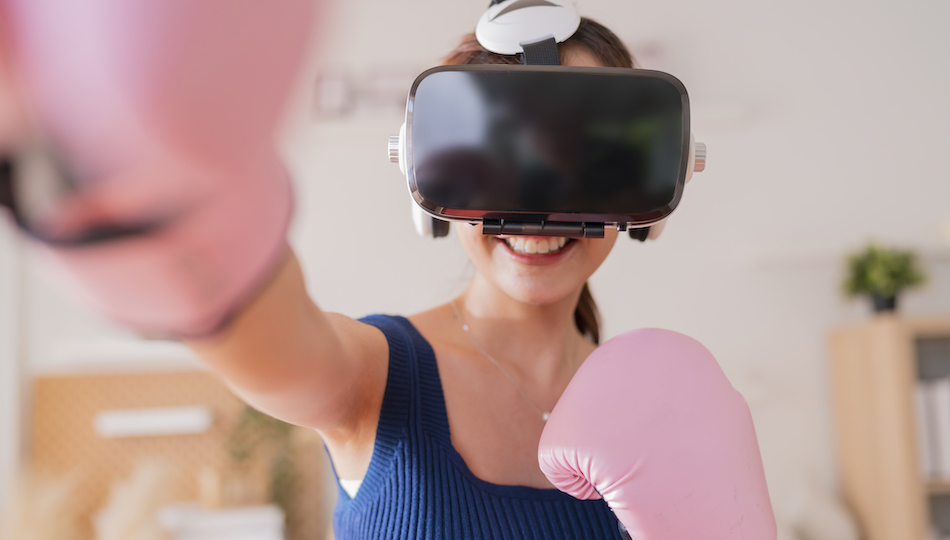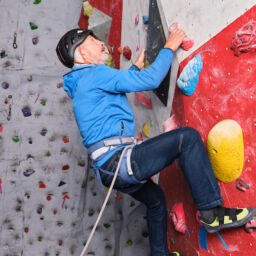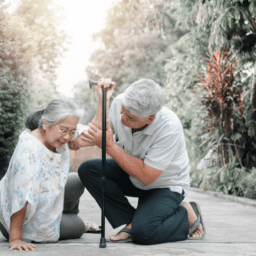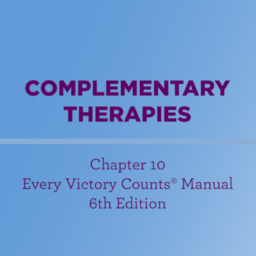For more than ten years, advanced virtual reality (VR) systems have been used in physical therapy and clinical trials for Parkinson’s. More recently, a growing number of people with Parkinson’s have begun to use VR systems to increase opportunities to socialize, exercise, and even enhance mindfulness and meditation practices. Some people with Parkinson’s, including musician Nenad Bach, who we recently interviewed, have even found that VR technology has helped improve their Parkinson’s symptoms.
Virtual Reality Systems Available Today
Virtual reality systems allow users to navigate a virtual world, and many types of VR systems are available today. One common way to categorize these systems is by how immersive they are.
The most immersive VR systems are those available in clinical settings. These systems allow users to walk or run in a virtual environment by using wrap-around screens, full-body motion-capture sensors, moving platforms that can mimic unstable surfaces, and harnesses that help prevent falls.
The VR systems available for in-home use are usually less immersive. For example, an in-home VR system may just include a computer program and video game where a user navigates a 3D environment from a first-person perspective on a standard screen or TV. A VR system may also be connected to a stationary bike or other exercise equipment to provide users with a more dynamic workout experience at home.
A more advanced home-based system will include a VR headset that blocks out most or all of one’s physical surroundings. These headsets can be used to play advanced, modern video games or traditional games like tennis, ping pong, and golf. They can also be used to enhance mindfulness and other exercises. Some VR headsets feature handheld controllers to facilitate your interaction with the virtual world, while others use motion-sensing technology to track the motions you make without requiring you to hold a controller. In addition, many home-based VR applications can be used sitting down, which can be helpful for people who experience balance issues.
In addition to VR systems, there are also augmented reality (AR) systems. Common AR systems include smartphone applications that use a camera and the device screen to display visual cues or overlay virtual images onto physical surfaces. Other AR systems do the same thing using glasses, a non-immersive headset, or a projector.
Current Uses and Benefits of Virtual and Augmented Reality for Parkinson’s
While VR and AR systems differ in how immersive they are, the dynamic interaction that VR and AR technology facilitates can help you become more accustomed to controlling your movement in response to changing circumstances.
One specific benefit of VR and AR systems is that they facilitate dual-task training in a controlled environment. Many people with Parkinson’s experience “dual-task interference.” Dual-task interference can occur with two simultaneous motor tasks, two cognitive tasks, or a combination of motor and cognitive tasks. Dual-task interference can contribute to falls and negatively impact the quality of life. The immersive environments created by VR systems can help lessen distractions and improve your dual-task performance by making it easier for you to concentrate.
An additional benefit of VR and AR systems is “gamified” environments. Physical therapists have used game-based approaches for a long time to help people improve dexterity and other aspects of movement. Gamified VR environments have some advantages over lower-tech therapy options, including capturing data and measuring progress objectively, controlling difficulty levels, and presenting challenges in precisely reproducible ways to encourage continued effort and improvement. Also, because VR and AR systems can be used at home, the benefits of these activities can be more easily accessed with greater frequency.
Recent Research: Motor and Cognitive Benefits of VR
As of early 2023, approximately 20 clinical trials are investigating using VR systems in physical therapy or other treatments for Parkinson’s.
For example, research is ongoing to determine whether practicing dual-task activities in a controlled, immersive virtual environment contributes to sustained improvement in dual-task ability outside of a virtual environment. Another trial is using an advanced VR system and an advanced deep brain stimulation (DBS) system to collect data to help understand what causes freezing of gait.
Some clinical trials involving VR and AR for Parkinson’s have gathered enough data to publish results. For example, a 2014 trial found that VR training corresponded with more significant improvements in obstacle avoidance and dynamic balance when compared to traditional balance, strength, and stretching exercises. A 2016 trial found that adding non-immersive VR to treadmill training led to a lower incidence of falling than training without VR. And a 2022 trial reported that people who had virtual reality training in addition to routine physical therapy “showed significant improvements in resting tremors, rigidity, gait, posture, body bradykinesia, arising from a chair, and rapid alternating movements, compared to patients assigned to a control group that received only physical therapy.” Even more recently, in February 2023, researchers reported in Nature that the use of an advanced immersive VR system “is highly effective for motor rehabilitation in patients with PD” and that participants also experienced improvements in “depressive symptoms, executive function, and some coping strategies.”
Notably, much of the research into VR/AR for Parkinson’s has involved small groups of people, and study authors tend to agree that larger studies are needed before conclusions can be drawn about the efficacy of VR/AR as a part of Parkinson’s therapy. Some research has even found that AR technology is detrimental for people with Parkinson’s. For example, a 2020 report from a research study examining the effects of AR on freezing of gait in Parkinson’s found that using an AR system to provide visual cues was not sufficient to improve freezing of gait. Moreover, this study found that participants using the AR system experienced a diminished ability to rotate and change direction while using the AR system compared to when they were not using the AR system.
A Davis Phinney Foundation Ambassador’s Perspective on How VR Can Help People with Parkinson’s
The fact that there is still much to learn about the benefits of VR and AR for people with Parkinson’s doesn’t discourage Davis Phinney Foundation Ambassador Joe O’Connor, a long-time fan of VR systems.
Joe says he enjoys VR because it “puts you into another world where you can experience so many different things. Want to explore new planets? You can do that. Want to drive a Formula One racecar? Climb Mount Everest? Visit the Titanic on the bottom of the ocean? With VR, you can do all that.”
Joe also appreciates how home-based VR systems help people connect with each other in new ways. “There is, of course, a VR chat feature, which is wide open,” Joe says. He adds that “it would not be too hard to form a Parkinson’s-only or other private group, and with the sport-based games, people could push each other to improve.” One example of this is the Ping Pong Parkinson’s championship series.
VR’s potential to help with at-home exercise also inspires Joe’s appreciation for the technology. “There is an old saying that the best exercise is the one you will do,” Joe notes, “and VR provides many ways to liven up your at-home exercise: you can box, ski, or sail a boat.”
Dynamic activities like sailing may not be accessible to all people with Parkinson’s in the “real” world, but in VR environments, people can engage in these activities from home. In many cases, these VR experiences can be used while sitting down. Even while sitting, VR systems challenge mobility and dexterity because they encourage people to rotate and move their limbs as they explore the virtual environment. The novelty of the experience may also help alleviate apathy, a significant non-motor symptom many with Parkinson’s face.
Living Well Today in a Futuristic World
VR technology’s usefulness in research and other clinical settings is well-established. Still, because of VR’s ability to facilitate immersive new experiences, challenge physical and cognitive performance, and connect people remotely from the safety of their homes, VR systems can be a powerful tool to help people with Parkinson’s and their families live well today.
VR technology is still a new, cutting-edge technology, but despite how much there is to learn about it, VR is—even today—a powerful tool for connecting people and providing new ways to learn, exercise, and have fun.
If you are interested in experiencing VR, there are many commercially available at-home VR systems and many websites that offer reviews and information about choosing the right system for you. Another option for exploring VR today outside of a clinical setting is to visit a VR lounge/arcade or a museum that features VR exhibits.
More Information
Design and Development of a Virtual Reality-Based Mobility Training Game for People With Parkinson’s
VR Game Allows Parkinson’s Patients to Move and Feel in Virtual Worlds
VCU Researchers Use Virtual Reality Games as Exercise Therapy for Parkinson’s | VCU Health
Using VR to Aid People with Parkinson’s [VCU Health] – YouTube
10 Totally Unique VR Experiences For Non-Gamers
Examples of Advanced VR/AR Systems
Virtual Reality Human Performance Laboratory (VGait) – Advanced Platform Technology Center
WANT MORE PRACTICAL ARTICLES LIKE THIS?
You can learn much more about living well with Parkinson’s today through our Every Victory Counts® suite of resources. Each manual is packed with up-to-date information about everything Parkinson’s. Click the link below to order your manual(s).
Thank you to our 2023 Peak Partners, Amneal, Kyowa Kirin, and Sunovion, and our Every Victory Counts Gold Sponsor, AbbVie Grants, for their ongoing support of these must-have manuals. Additionally, we’d like to thank Barbara and Dale Ankenman, Abby and Ken Dawkins, Bonnie Gibbons, Gail Gitin in loving memory of Gene Gitin, Irwin Narter, and Lorraine and J Wilson for their generous donations that allow us to make these resources available and free to all.

















